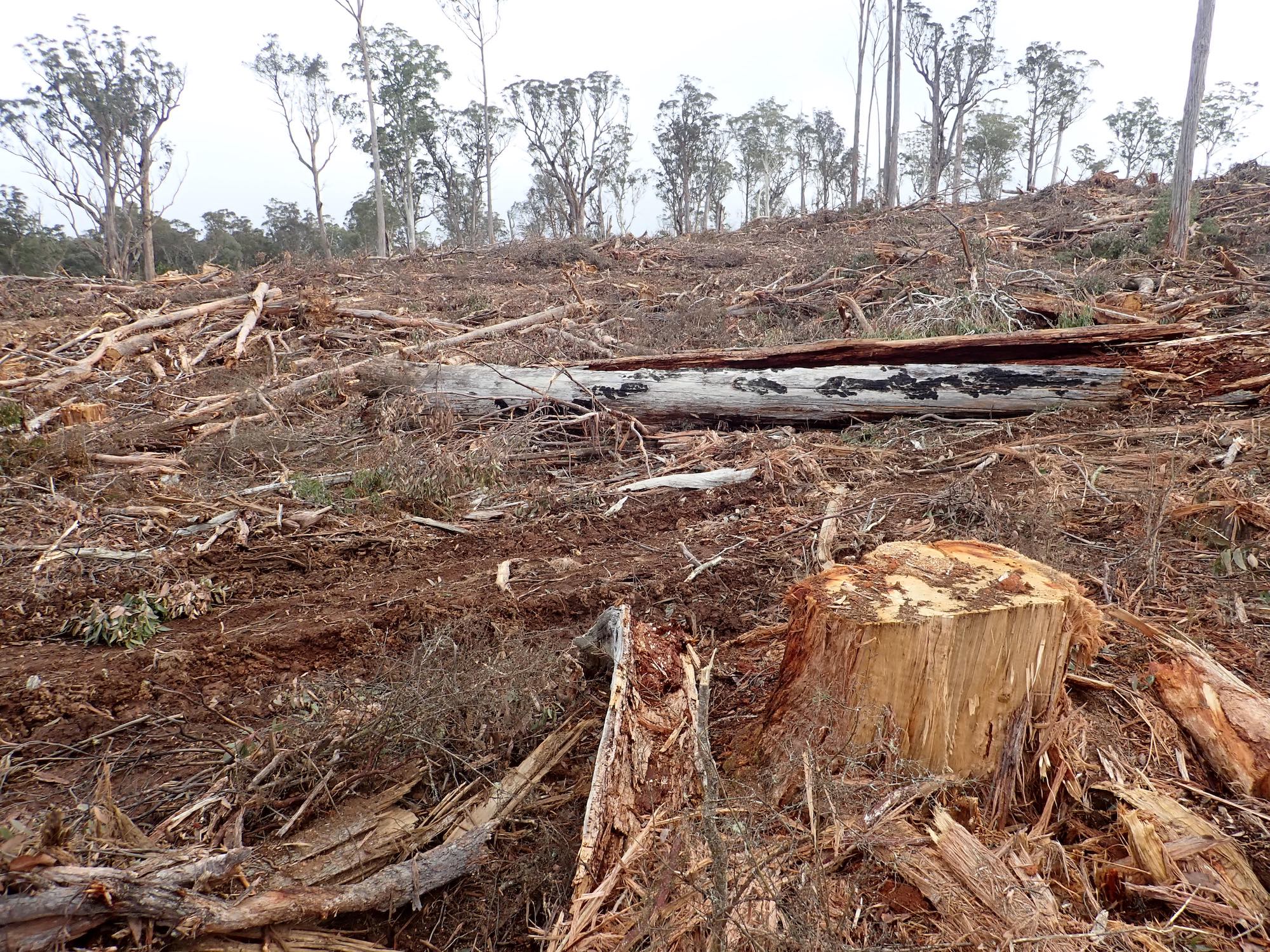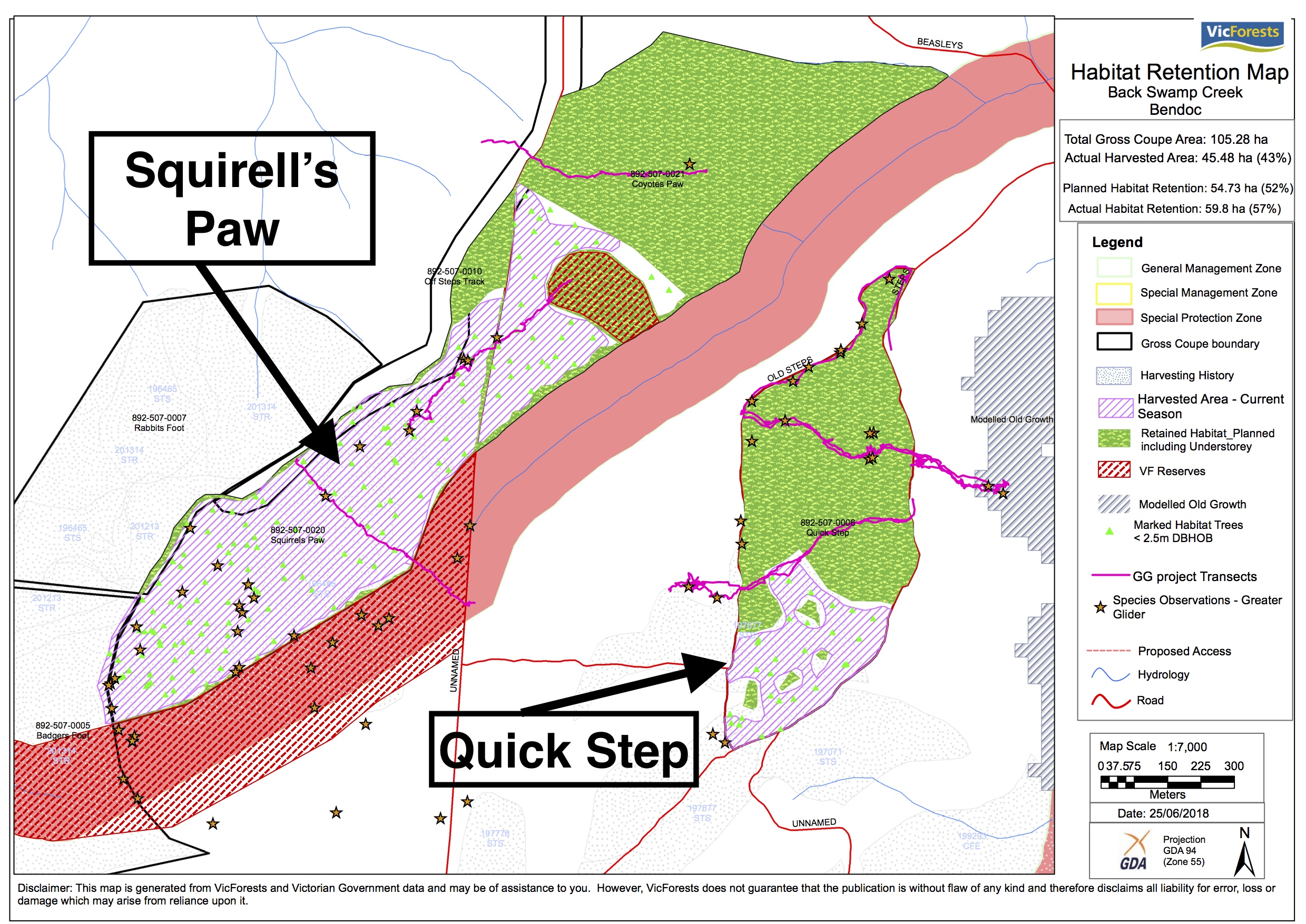In late July ABC news exposed a shocking experiment being conducted by state owned logging company VicForests. The agency is logging the habitat of Greater Gliders, an animal already threatened with extinction, to see how many survive.
VicForests released a lengthy statement justifying the so called 'research' that has been labelled the terrestrial equivalent of so called scientific whaling.
Click here to view the ABC news TV story.

Let's break down this dodgy experiment and take a look at just how bizarre the methodology appears to be.
VicForests has two main sites within the project where logging has occurred.
The first site is called "Squirell's Paw" and has been logged using standard methods that basically clear the entire forest.

Photo: Logging in the 'Squirrel's Paw' site
The other main site is called "Quick Step". It has been partially logged with the northern section of the logging coupe retained.

Photo: VicForests high retention logging site 'Quick step' as shown on ABC news
So how will these different methods of logging yield useful and statistically significant data on whether or not Greater Gliders can withstand logging?
Existing research shows they will not.
"Squirrel's Paw"
In this site logging has been most intense. Before logging this area VicForests conducted spotlighting surveys in the forest to look for Greater Gliders. They only surveyed a small section of the coupe and they managed to find several Greater Gliders in the northern section of the coupe.
GECO and the FFRC conducted their own surveys in the coupe and undertook spotlighting in the southern section, where VicForests had failed to look for Greater Gliders. Our surveys found 11 Greater Gliders within a distance on 1km. This should have triggered regulatory protection as it met the requirements to implement a special protection zone. The regulation requires more than ten gliders in 1km to be found to establish a protection zone.

Photo: The precise location where our surveys located a Greater Glider, where is it now?
We submitted a report to the environment department calling on them to halt the logging and protect the forest in accordance with the law. Logging continued for two days before the department took action, during these two days at least two sites where we had recorded Greater Gliders were logged. This almost certainly resulted in the death of those gliders.
After allowing logging to continue for two days the environment department conducted a follow up survey to 'verify' our findings. The department survey found 10 Greater Gliders within 1km, just one short of meeting the threshold for protection.
Instead of taking a precautionary approach and conducting a second survey to see if they could find enough gliders to match the threshold for protection, the department immediately allowed logging to resume.
Logging occurred in the precise locations where we had found Greater Gliders in the southern section of ’Squirrel’s Paw’. Logging also occurred in the areas of the forest where VicForests had detected four Greater Gliders, the entire home range areas of these gliders has now been cleared, very likely resulting in their death as well.
We are unsure if there were surveys conducted to find dead or injured Gliders during or immediately after felling the gliders’ trees. We believe that this experiment should not have gone ahead without an animal ethics committee approval, regardless of its approval under the logging schedule and regardless of whether VicForests surveys had approval.
Any post logging monitoring that is carried out at this site within the next 80 years is unlikely to find any surviving gliders as a large body of scientific literature has already concluded that gliders die when their home ranges are logged. In fact this is what the government's own scientific advisory committee wrote when they recommended the Environment Minister Lily D'Ambrosio list the species as vulnerable under state law.
"The species does not cope well with habitat change. Although the animals may not die from the initial impact they will die shortly afterwards. This is due to life history traits: affinity with home range, small home ranges, attachment to hollow bearing trees they use for denning and their specialist diet." - Scientific Advisory Committee.
"Quick Step"
This site is VicForests so called "High retention" site where extra trees are left behind to supposedly help the Greater Gliders. Logging has occurred in the southern section of this forest stand, however the section of the coupe that has now been logged was not surveyed for Greater Gliders before logging, so there is no baseline data for this area.
Instead of searching for Greater Gliders in the areas where logging was planned, VicForests instead chose to look for Greater Gliders in the northern section of the coupe where no logging was planned.
This raises doubts as to how VicForests expect any reliable data to be produced from their planned post logging monitoring. A logical approach would be to search the areas impacted by logging for the presence of Greater Gliders before logging takes place and then search the same areas again post logging to compare results.
Without this crucial information, post logging monitoring will be pointless as no data was collected prior to logging so no comparisons can be made.

The map above shows VicForests pre logging survey transects (areas walked where spotlighting was conducted to look for Greater Gliders prior to logging). These are displayed as pink lines.
The map clearly shows that in the Squirrel's Paw coupe (on the left) VicForests found Greater Gliders, along transects that they walked. These areas have now been logged which has resulted in the death of those gliders.
To the right is the "Quick Step" logging coupe. The green area has not been logged and is where VicForests did find Greater Gliders. So these Greater Gliders are likely to be doing just fine because their habitat was not logged. However, in the logged southern section of the coupe no effort was made to look for Greater Gliders.
Again, VicForests won’t be able to show whether this logging has impacted on Greater Gliders at all as no one will ever know if the forest was used by this protected species before it was cleared.
Not only is VicForests experiment unethical and unnecessary, it's also appears to be completely lacking in scientific rigour.
Take action - Email the Minister's responsible for VicForests calling on them to stop the experiment and protect East Gippsland's forests.
Send the Ministers an email here.
